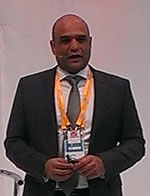
Recently I was following a few events where the core theme was digital transformation. One of them had SAP’s Sameer Patel as a speaker.
I noticed this tweet with a picture of Sameer and a quote from someone who attended his presentation. It read: “Who owns the audience, owns the last mile. Closest to customer, closest to disruption, shift”. Even if Patel has a problem with the word disruption – as I now and then do – he talks a bit more about the mentioned last mile in a blog post “Why true disruption requires putting the last mile, first“. I agree with the tweeted quote.
And in more than on regard there’s a striking resemblance with what Charlene Li said in our interview on engaged leadership, transformation, disruption and her new book “The Engaged Leader”.
Quote from that interview with Charlene Li: “Why go through digital transformation? The anchor: the customer”. Second quote: “Disruption in the end is a shift in power in relationships”. And these relationships are with customers, audiences, employees, the ecosystem within which your organization resides, etc.
We haven’t digitally transformed, we digitized
In fact, I’ve been planning a post on the only thing that really matters in digital transformation and it really is the customer but then in the broadest possible sense and in an enterprise-wide or rather ecosystem-wide view on digital transformation (not just the customer experience or digital – integrated – marketing context with which it unfortunately often is confused with). And then the customer becomes the board, the knowledge worker, the business partner, the regulator etc. too and we start speaking about revenue, business models, process optimization, cost reduction, information management and so on. Businesses really don’t just transform because the customer in the strict sense needs to be served in different ways. Customers are put in the center of many transformation efforts because organizations have little choice and think about their bottom line.
Back to Sameer Patel and the reason of this post. Sameer also talked at the 2014 edition of CeBIT, where I was present and listened to his presentation. It was scheduled in a social business and social collaboration “arena” and the host who introduced him started by asking if digital transformation was the next big thing as he wasn’t going to talk about social (business). Times are changing fast and so are the terms of the day but both are certainly very actual.
[blockquote author=”Sameer Patel at CeBIT 2014″]65% of a sales rep’s time is spent looking for information rather than selling [/blockquote]Many organizations are de facto starting to see clearer into the whole reality of social business. Sameer Patel replied by saying there is a link with digital business and social business but that “digital transformation is the next incarnation of what the promise of technology should have always been”.
Patel wondered if we had truly transformed the ways we conducted business and worked or if we had just digitized. Have we really derived the value from everything we digitized (from paper to process) and really transformed the way we work? The answer was a clear no and Patel gave a few examples. “If we have digitally transformed how we work”, he asked, “then, why does the average worker still spend over 20% of their time looking for information and 28% managing email?“.
Good point. Here’s another one: “if social CRM, that promised to break the walls between service, support and sales with a single view on the customer and transforming the way we sell, then why is it that 65% of a sales rep’s time is still not spent selling”? Or this one regarding procurement: “if we have digitally transformed how we procure, then why do 43% of companies still not have complete information on suppliers?”.
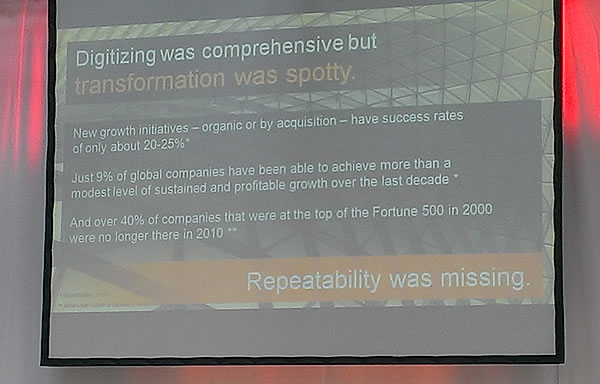
Digital transformation and the reality of digitization and automation
The SAP SVP continued his presentation, explaining the core issues at stake and how to solve them.”To truly transform”, he said, “we need to look for and institutionalize repeatable patterns”.
Among the challenges? Processes are ad hoc, systems are fragmented, data creates chaos and expertise networks are disconnected.
The roadmaps and realities of digital transformation became clear and become clearer every day. Yet, at the same time, just as is the case in social business, we see that many organizations still have to catch up with many of the issues Patel mentioned. And even that is not enough.
[blockquote author=”Sameer Patel at CeBIT 2014″]43% of companies are struggling with incomplete information in their procurement processes [/blockquote]When Patel said that we have digitized and not transformed I asked him if what he thought about the fact there is still so much digitization to do or: have we really digitized yet? Of course it depends but one does not work without the other and although many organizations started digital transformation initiatives, there is still a lot to do in the digitization area. The road can be long and winding.
Digital transformation happens in many areas but we’re merely seeing a small tip of the iceberg ahead of us. And if there are still so many challenges regarding the automation of core processes and the digitization of paper, then it’s probably time to start tackling those asap in a reality of extremely fast changes.
Here are 3 facts Sameer Patel shared at CeBIT 2014 – some of which you probably now – that I would like to share with you:
- New growth initiatives – organic or by acquisition – have success rates of only about 20-25%.
- Just 9% of global organizations have been able to achieve more than a modest level of sustained and profitable growth over the last decade.
- Over 40% of companies that were at the top of the Fortune 500 in 2000 were no longer there in 2010.
It’s time to create the conditions that make digital transformation initiatives at the very least possible it seems – and truly digitize.
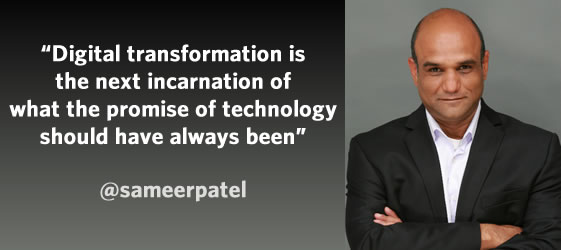
Digital transformation and how to look for and institutionalize repeatable patterns
Let’s now look at why we need to “look for and institutionalize repeatable patterns” in digital transformations as Sameer Patel put it and how to get started.
The approach Patel explains doesn’t aim to be the “only answer” as he emphasizes. The key goal of it all is not copying the analogue world or digitizing as we did so far, according to him (even if there is still quite some digitization to do) but to accelerate performance with genuine digital transformation.
Patel takes a human approach – that of the employee – and says each employee has 3-4 work patterns they fall under (note: Patel’s focus on the employee and work patterns is related with his function at SAP: SVP, Products & Go-to-market SAP Cloud / Successfactors).
If you’ job is to sell, for instance, these patterns are how you prospect, how you manage an account etc. Sameer provides a framework for patterns, taking the best ways to work, and federating it across the organization. Such a framework, he says, needs four things. Let’s take a look at all four.
Four elements of a digital transformation framework to accelerate performance
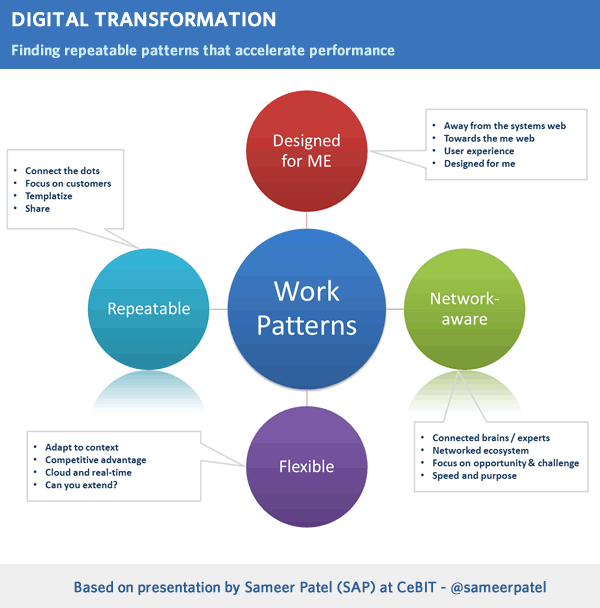
1. Repeatable
It needs to be repeatable so it can be templatized in a way that it can be shared with others. Repeatable means having the ability to bring together your best experts, content, data, applications and best practices around each solution. An example: if you sell or service customers, the question is whether you can quickly wrap around the customer’s information, requests, data etc. and know who the best people in the organization are etc. to act.
It’s the increasingly real-time need to connect the famous dots between people, processes, data and applications or tools with a task, a goal in mind. In a customer context, we can translate it into the – also famous – single customer view across the organization with the right information, resources, people, etc. at the right time for a customer with higher expectations than ever before.
This ‘rule of repeatability’ can of course also be applied to other areas than selling or servicing.
2. Designed for “Me”
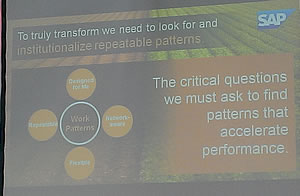
It needs to be designed for “me”, not around systems. In other words: the user/customer comes first whereby we move from what Sameer calls the “systems web” to the “me web”. It’s the shift we see in IT whereby the (end)users, in this case your employees and partners, of the systems you havewill use what they want to use and the days of IT telling to use an application just like that are over.
It’s also about the customer in a broader sense. An example, referring to my previous piece on Patel’s keynote I wrote elsewhere: information needs to come to “me”, the employee, instead of the employees having to waste time looking for the information they need to do their work better, faster and in a more “me” way.
This should really be a no-brainer but the reality shows us it’s different with loads of wasted time and resources that could be used to service customers, sell, innovate: to get the actual job done. This, for me, is a crucial element in enterprise-wide digital transformation projects. What we’re really talking about here is user experience (the employee,….) and also customer experience.
[blockquote author=”Sameer Patel”]If we have digitally transformed how we work, then, why does the average worker still spend over 20% of their time looking for information and 28% managing email?[/blockquote]3. Network-aware
It needs to be network-aware. When an incident, business problem or opportunity hits you, you need to be able to tap into the networked ecosystem of the business to act upon it.
We spent the last two decades outsourcing a lot of what we do, such as supply chains, Sameer Patel reminds us. Network-awareness in this context essentially means leveraging these (outsourcing) partners and bringing them back in (by creating networks) and connecting the ‘brains’ of such partners and of suppliers and the overall ecosystem.
This connectivity doesn’t need to be done for the sake of it but to be able to instantly wrap your network of what Sameer calls employee, customer and partner experts around a problem or opportunity. In other words: networked with a purpose and with speed as a key element.
[blockquote author=”Sameer Patel”]If social CRM, that promised to break the walls between service, support and sales with a single view on the customer and transforming the way we sell, then why is it that 65% of a sales rep’s time is still not spent selling?[/blockquote]4. Flexible
It needs to be flexible, despite also being repeatable, as repeatability doesn’t mean one solution/approach/pattern fits all. Can you extend it? Can you even make a competitive advantage out of it?
Here Sameer Patel mentions the ability to adapt in real-time and (obviously) mentions the cloud as a fast and flexible way to differentiate and win. More important is the question whether you can extend it he emphasizes though.
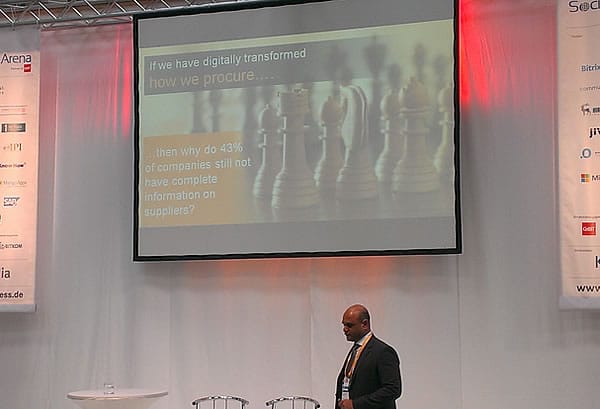
Integration – or a holistic understanding
It’s not about collaboration, it’s not about a solution, it’s not about something SAP did, that’s now what users are asking for, Sameer Patel says. It’s holistically understanding what are these right patterns between social, people, processes and data that I need to have around “me”, as an employee, manager and, yes, even leader.
Having the flexibility, designing for adoption and function first (and social second), being able to extend and scale, centred around the “me” in apps, devices and networks and able to drive competitive advantage.
That’s in a nutshell what Patel’s digital transformation message regarding the need to find patterns that accelerate performance – and scale – is about.

